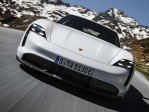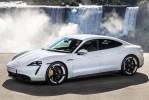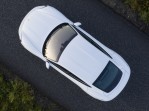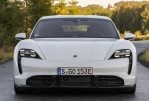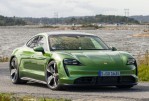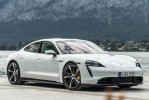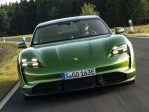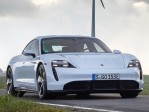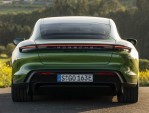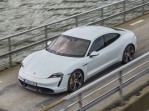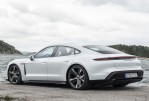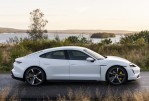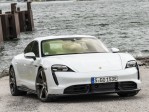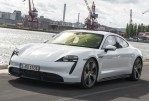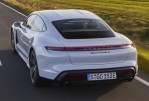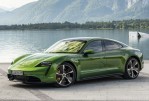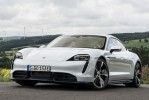Segment: Upper Premium
Infotainment: ![]() Apple CarPlay
Apple CarPlay ![]() Android Auto
Android Auto
Production years: 2019, 2020, 2021, 2022, 2023, 2024
Review: Porsche Taycan (4S, Turbo, Turbo S) Track Test
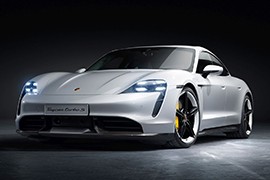 68 Photos
68 PhotosPorsche introduced its first electric vehicle in 2019, the Taycan, a model that was previewed as a concept car in 2015 as the Porsche Mission E.
The German sports car maker Porsche surprised its customers with its electric vehicle. Not that they didn’t expect to see an electron-powered vehicle from this brand, but because it used the “Turbo” name on it, even though electric vehicles are not turbocharged. But the automaker said it used this moniker to reveal the different versions of the vehicle. Later, it added the 4S and the S versions, following similar designations to the ones used on the Porsche 911 or the Panamera. The Taycan Turbo was unveiled in 2019 at the Frankfurt Motor Show along with its more powerful sibling, the Turbo S. While at first its fans were intrigued, later they embraced the idea and put down their money to buy the first high-performance all-electric European production car.
The automaker made the Taycan lineup a practical, four-door sedan vehicle fit for families but with a driving behavior typical for a Porsche. Its design language followed the same principles as the rest of the carmaker’s range, featuring a low and flat nose for the hood that was flanked by slightly taller fenders. For the headlights, the automaker used four distinct LED blocks for the adaptive headlamps. On the lower side of the bumper, Porsche installed a broad grille with a black integrated splitter where the radar for advanced safety systems took center stage. From its profile, the Taycan Turbo featured tall door panels and a low greenhouse, typical to the 911 range. The rounded lines and the sloped-down roofline were continued at the back by a short trunk lid. Following its design ideas, the automaker installed a red stripe of LEDs for the taillights and, underneath it, the Porsche lettering. Under the rear bumper, a functional diffuser confirmed the car’s sporty character.
Inside, customers were greeted by a wide display mounted on the dashboard. Besides the digital instrument cluster, Porsche installed a 10.9” infotainment touchscreen atop the center stack, while a third touch-sensitive display was available on the passenger’s side. The automaker installed a set of sport bucket seats at the front with high bolstered areas that kept its occupants in place during high-speed cornering maneuvers. In the back, the automaker installed two bucket seats separated by a center area where a third person couldn’t sit. Moreover, there were just two seat belts for the rear-seated passengers. Finally, for the trunk, the automaker installed two: one at the front and one at the back. Their combined volume was unimpressive, offering just 447 liters (15.8 cu-ft.) split between 80 liters (2.8 cu-ft.) at the front and 366 (12.9 cu-ft) at the rear.
Porsche installed a pair of electric motors that powered both axles. The front motor offered 175 kW (235 HP), while the rear one had 335 kW (449 HP) for a combined total value of 500 kW (670 HP) that could rocket the car from naught to 60 MPH (0-97 kph) in three seconds flat. Its maximum range was 450 km (280 miles).
PORSCHE Taycan Turbo 2019, 2020, 2021, 2022, 2023, 2024
- 460 KW (625 HP)
- S 460 KW (625 HP)
PORSCHE Taycan Turbo
460 KW (625 HP)
ENGINE SPECS - 460 KW (625 HP) | |
|---|---|
| Power: | 459.7 KW @ - RPM 625 HP @ - RPM 616 BHP @ - RPM |
| Torque: | 627 lb-ft @ - RPM 850 Nm @ - RPM |
| Fuel System: | Electric |
| Fuel: | Electric |
PERFORMANCE SPECS | |
|---|---|
| Top Speed: | 162 mph (261 km/h) |
| Acceleration 0-62 Mph (0-100 kph): | 3.2 s |
TRANSMISSION SPECS | |
|---|---|
| Drive Type: | All Wheel Drive |
| Gearbox: | 2-speed automatic |
BRAKES SPECS | |
|---|---|
| Front: | Ventilated Discs |
| Rear: | Ventilated Discs |
TIRES SPECS | |
|---|---|
| Tire Size: | 245/45 R 20 103Y XL // 285/40 R 20 108Y XL |
DIMENSIONS | |
|---|---|
| Length: | 195.4 in (4963 mm) |
| Width: | 77.4 in (1966 mm) |
| Height: | 54.3 in (1379 mm) |
| Front/rear Track: | 67/65.6 in (1,702/1,666 mm) |
| Wheelbase: | 114.2 in (2901 mm) |
| Cargo Volume: | 12.9 cuFT (365 L) |
| Aerodynamics (Cd): | 0.22 |
WEIGHT SPECS | |
|---|---|
| Unladen Weight: | 5082 lbs (2305 kg) |
POWER SYSTEM SPECS | |
|---|---|
| Nominal Capacity: | 93.4 kWh |
| Range: | 237 miles (381.4 km) |
| Notes |
|---|
| Overboost power: 500 KW (680 HP) Combined electricity consumption: 26.9 KWh / 100 Km Charging time for alternating current (AC) at 11 kW from 0 to up to 100%: 9.0 hours Charging time for direct current (DC) at 50 kW for up to 100 km (WLTP): 28 min Charging time for direct current (DC) at 270 kW for up to 100 km (WLTP) under optimum conditions: 5 min Charging time for direct current (DC) at 50 kW from 5 to up to 80%: 93 min Charging time for direct current (DC) at 270 kW from 5 to up to 80% under optimum conditions: 22.5 min |
PORSCHE Taycan Turbo
S 460 KW (625 HP)
ENGINE SPECS - S 460 KW (625 HP) | |
|---|---|
| Power: | 459.7 KW @ - RPM 625 HP @ - RPM 616 BHP @ - RPM |
| Torque: | 774 lb-ft @ - RPM 1050 Nm @ - RPM |
| Fuel System: | Electric |
| Fuel: | Electric |
PERFORMANCE SPECS | |
|---|---|
| Top Speed: | 162 mph (261 km/h) |
| Acceleration 0-62 Mph (0-100 kph): | 2.7 s |
TRANSMISSION SPECS | |
|---|---|
| Drive Type: | All Wheel Drive |
| Gearbox: | 2-speed automatic |
BRAKES SPECS | |
|---|---|
| Front: | Ventilated Discs |
| Rear: | Ventilated Discs |
TIRES SPECS | |
|---|---|
| Tire Size: | 265/35 ZR 21 101Y XL // 305/30 ZR 21 104Y XL |
DIMENSIONS | |
|---|---|
| Length: | 195.4 in (4963 mm) |
| Width: | 77.4 in (1966 mm) |
| Height: | 54.3 in (1379 mm) |
| Front/rear Track: | 66.5/65.2 in (1,689/1,656 mm) |
| Wheelbase: | 114.2 in (2901 mm) |
| Cargo Volume: | 12.9 cuFT (365 L) |
| Aerodynamics (Cd): | 0.22 |
WEIGHT SPECS | |
|---|---|
| Unladen Weight: | 5060 lbs (2295 kg) |
POWER SYSTEM SPECS | |
|---|---|
| Nominal Capacity: | 93.4 kWh |
| Range: | 242 miles (389.5 km) |
| Notes |
|---|
| Overboost power: 560 KW (761 HP) Combined electricity consumption: 26.9 KWh / 100 Km Charging time for alternating current (AC) at 11 kW from 0 to up to 100%: 9.0 hours Charging time for direct current (DC) at 50 kW for up to 100 km (WLTP): 31 min Charging time for direct current (DC) at 270 kW for up to 100 km (WLTP) under optimum conditions: 5.5 min Charging time for direct current (DC) at 50 kW from 5 to up to 80%: 93 min Charging time for direct current (DC) at 270 kW from 5 to up to 80% under optimum conditions: 22.5 min |



















